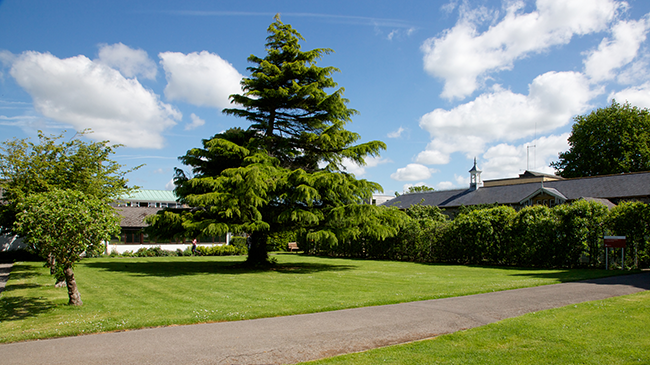Langford Grounds
At the University's Langford campus, you'll find a 255-hectare estate. Staff and students can explore this expansive area, which boasts a diverse range of trees and plants. Unwind between lectures, go for a leisurely stroll during your lunch break, or have a picnic with friends.
On this page
Visiting and using the gardens
Langford Grounds are open daily, all year round, to staff and students.
Address
Things to see and do
Take a walk through the pear arch, help out at the student allotment, admire the plants in the glasshouse, or visit the summer house. There's plenty of space here to have fun with friends or enjoy some quiet time alone in nature. More to see and do in these gardens:
Trees and plants

Our Langford Grounds have a mixture of herbaceous borders, shrubberies and smaller ornamental trees such as cherries and crab apples. There are also larger specimen trees such as hornbeams, cedars, wellingtonia and red oaks.
Many areas previously treated as lawns are now being managed as meadows. We are experimenting with sowing wildflower mixes in some of these areas.
Surrounding the campus are livestock fields, with large trees such as cedars, wellingtonia, oaks, field maples and beech.
We survey our trees annually, to monitor their health. You can see information about all our trees, with photographs, on our online map.
If you are in the garden, you use the QR codes on many of our larger or more unusual trees to find out more about them on the online map.
Seasonal interest
There's beauty to enjoy in every season at our Langford Grounds.
In spring, you'll see Narcissus flowers at the entrance, along with blooming cherries and crab apples.
Summer brings more flowers in the herbaceous borders. Our newly replanted long borders in the walled garden promise a beautiful display through late summer and autumn.
Autumn brings colourful leaves from the many trees on site.
In winter, admire the bare trees and colourful dogwood stems. Ornamental grasses add movement and winter box plants fill the air with their sweet scent.
Wildlife and nature
Our site is home to a variety of birds, from flocks of goldfinches to majestic buzzards and ravens. A red kite was spotted over the campus last year.
You'll also find bees, butterflies, and other insects in the meadow areas and on the herbaceous borders. We're proud to host two apiaries run by the North Somerset beekeepers.
Look out for voles and rabbits – they're commonly seen around here too.
Volunteer
Students and staff can join organised volunteering sessions to support the student allotment. If you are interested in volunteering your time and meeting people who are interested in growing plants, email the allotment group at grp-allotmentclub@groups.bristol.ac.uk. No experience is required.
Instagram for our gardens
See what others are doing in the garden and add your own images #unibrisgardens or tag us in your stories @unibrisgardens.
Facilities
- Access
- Parking
- Bike storage
- Refreshments and toilets
- Seats and benches
- Code of conduct
- Hiring Langford Grounds
Access
Langford Grounds feature a mixture of surfaced and unsurfaced paths with some uneven terrain.
Parking
Parking on the Langford Campus is for students, staff and visitors only. You can park in all general parking spaces on campus, as no spaces are allocated to certain buildings and users. The only exception being disabled, electric vehicle, delivery and Langford Vets client bays.
Bike storage
You can store your bike near the Langford Grounds.
Find where you can store your bike on campus.
Refreshments and toilets
The nearest University Source Cafe is the Langford Cafe. This is open to the public.
There is a toilet at the Source Cafe.
Find Source Cafe opening hours.
There are three drinking water fountain locations at the Langford Campus.
Seats and benches
There are several benches near the paths all around the grounds.
Code of conduct
This is a private garden, and we expect visitors to treat the space with respect and courtesy.
- Take your litter home with you.
- Keep dogs on a lead.
- Clean up after your dog.
- Supervise children.
- Stick to paths, avoid disturbing wildlife, and don't damage property, trees, plants or lawns.
- No barbecues, fires, camping, skateboarding, or aggressive cycling.
- Follow additional safety instructions, if there are building works taking place.
Hiring Langford Grounds
You can hire Langford Grounds for your own event or function.
To hold an event at the Langford Grounds:
- Staff, students and members of the public should contact our events team.
History of the site and the grounds design
Find out more about the history of the site how the grounds design has evolved.
In the 19th century, there were extensive green houses and drives on the estate. One greenhouse remains, having been restored in the 1990s. The original ironwork is still in place.
A ha-ha now separates the garden from the parkland, with the 100-meter pear arch on the site of the old greenhouses.
The age of the trees on the current estate suggests that many trees were planted in the 1800s, where evergreens were collectable at the time.
Research in Langford Grounds
Our gardens and green spaces are often used for research projects involving:
- small mammals such as bats and birds
- larger mammals such as badgers and foxes
- insects such as moths and bees.
We welcome researchers and research projects from various disciplines, including archaeology, art history, biological sciences, geography and geology.
